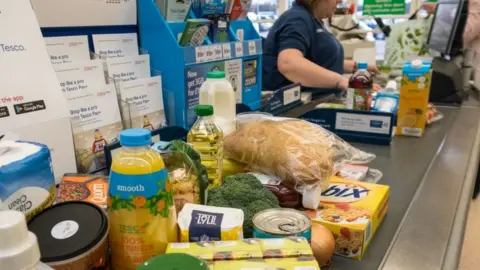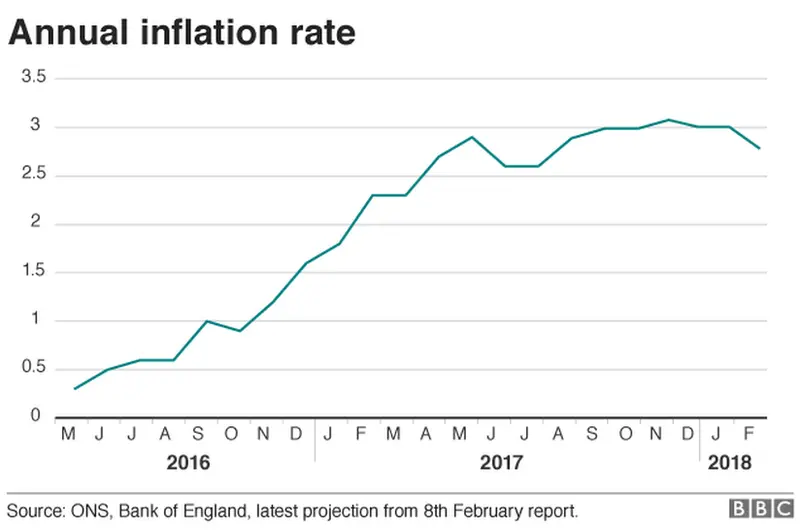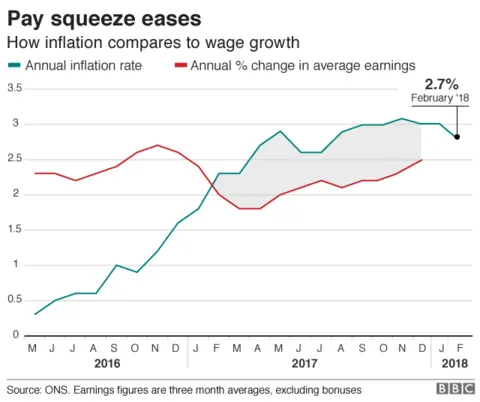Inflation eases to 2.7% on falling petrol prices
 Getty Images
Getty ImagesFalling petrol prices and a slower rise in the cost of food contributed to a drop in UK consumer price inflation during February.
The rate fell from 3% to 2.7%, the lowest figure since July 2017.
The fall eases pressure on the Bank of England to raise interest rates. There had been speculation it could raise rates at its meeting in May.
The figures suggest the squeeze on households, caused by rising inflation and stagnant wages, may be ending.
The ONS will publish the latest pay growth figures on Wednesday.
Economists expect those figures to show pay growth edged higher, to an annual rate of 2.6% in the three months to January.
And the situation could improve further this year, according to the Bank of England. It expects wages to grow more quickly than inflation.
The price of petrol and food played a key part in this month's figures.
Petrol prices fell by 0.2p per litre on the month, while diesel dropped by 0.1p.
Food prices rose by 0.1% between January and February, compared with a 0.8% rise the year before.
Last year's figure was boosted by a shortage of salad and vegetables, when crops in southern Mediterranean countries were hit by bad weather.
The main rise in the cost of living came from clothing and footwear prices, especially women's shoes, which went up by 1.7% on the month, compared with 1.2% in 2017.
Pound pressure eases
Consumer price inflation hit a six-year high of 3.1% in November and has been edging lower since then.
Phil Gooding, from the Office for National Statistics, said: "Many of the early 2017 price increases due to the previous depreciation of the pound have started to work through the system.
"Hotel prices also fell and the cost of ferry tickets rose more slowly than last year, when prices were collected on Valentine's Day, when many people could have been taking mini-breaks.

Mel Stride, financial secretary to the Treasury, said: "We know families feel the cost of living at the end of every working week.
"We are increasing the National Living Wage which is already helping the lowest earners see their pay rise by almost 7% above inflation."

Analysis: Kamal Ahmed, economics editor
The inflation drop suggests that the pay squeeze is easing.
Incomes data do lag prices, but if the trends continue (inflation easing and wages increasing) then it is likely that many millions of people will see their real incomes start rising again by the end of the year.
Which is much better news than we have had recently, particularly after the inflation spike which followed the Brexit referendum and the fall in the value of the pound.
That increased the import prices of things like food and fuel, which pushed up costs here.

That does not mean Britain's incomes problem is over.
As the latest Resolution Foundation report, The Living Standards Outlook, revealed, the last decade has seen the most anaemic rates of wage growth for 200 years.
Before the financial crisis, average wage growth topped 4% but since 2009 it has been below 3% and benefits for those in work have also been cut.
Yes, there have been increases in things like the National Living Wage, but the government is well aware that, overall, the picture on incomes is pretty gloomy.

Andrew Sentance, senior economic adviser at PwC, said: "It is not a surprise to see UK inflation starting to fall back.
"Forecasters were expecting price increases to ease back this year. But the rate of reduction is likely to remain slow and volatile. The fact that Easter is early this year could push inflation back up again in March.
"This fallback in inflation therefore provides little reason for the Bank of England to hold back from gradually raising interest rates.
"A further interest rate rise would be justified this spring."
However, Samuel Tombs, chief UK economist at Pantheon Macroeconomics, said: "Inflation is falling back to the 2% target much more rapidly than the Monetary Policy Committee (MPC) expected - undermining the case for raising interest rates again as soon as May.
"We think that the MPC will refrain from ratcheting up its guidance and won't clearly signal an imminent rate rise in the minutes of Thursday's meeting, prompting markets to reassess their view that the chances of a May rate hike are as high as 80%."
